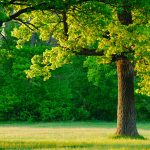Spring Pruning Guide for Young Trees
Is spring pruning a good idea? The answer depends on the type of tree and its condition. We’ll tackle this topic in two parts. This post covers general guidelines and spring pruning for trees up to about 3 years old. Part 2 will cover pruning established and mature trees.
Regular pruning keeps your trees healthy. The best time to prune most trees is when they’re dormant. In the Pacific Northwest, that’s generally in winter and early spring. You can prune at anytime, but cutting during the growing season affects growth.
Pruning Young Trees
A newly planted tree often needs no pruning. A young tree is establishing roots and storing food. Pruning removes the leaves it needs to photosynthesize and get nutrition.
Once a tree is established, after about 2 years, it needs annual winter or early spring pruning. Shaping a tree while it’s young ensures it grows into an ideal shape. Use a sharp, clean bypass pruner to remove small branches. Cut at an angle, close to a node.
Here’s how to prune young trees:
- The first year: Remove broken branches. If the new tree has a second leader, or vertical stem at the top, remove the weaker one.
- The second and third year: Cut branches to give the tree shape and wind resistance. Remove branches that are growing toward the center of the tree. Remove branches that cross another branch, or crowd out light or air. In general, don’t remove more than about 25 percent of a tree’s size.
Pruning Guidelines for Shade and Ornamental Trees
Here are the basics of tree pruning in Oregon and Washington. These recommendations are for both young and mature trees.
- All year: Remove broken, diseased and dead branches as soon as you notice them. Remove root suckers.
- Winter and early spring: Encourage growth by pruning during the dormant season. Remove branches to shape the tree and allow air and light into the canopy.
- Spring and summer: It’s best not to prune heavily during the growing season, though light pruning won’t harm trees. Removing branches once buds are set slows growth and reduces the tree’s food supply.
- Don’t top trees: Topping is the removal of the upper portion of the branches. This practice permanently disfigures the tree. The large cuts make the tree vulnerable to decay, insects and disease.
Rely on Inexpensive Tree Care for Pacific Northwest Tree Pruning
Our skilled arborists help keep trees of any age healthy. If you have a large tree, please contact us at (503) 679-1410. We have the equipment and expertise to safely remove branches from tall trees.
A tree lives a long life when we nurture it. The trees in your yard could live decades with the proper care. As the old English proverb goes, “If you want to be happy for a year, plant a garden; If you want to be happy for life, plant a tree.”




